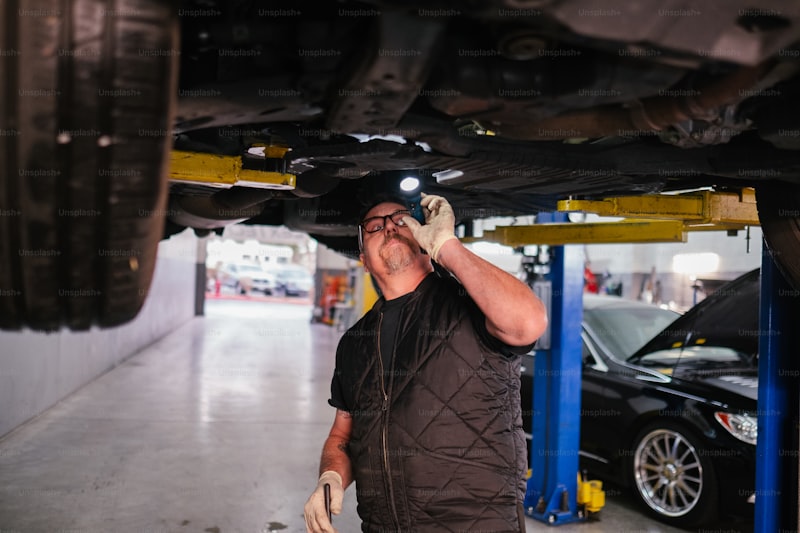Firstly, check your air filter. A clogged or dirty filter can restrict airflow and reduce the efficiency of your AC system. Replace the filter if it’s dirty, as this simple step can often solve many cooling issues.
Next, inspect the thermostat settings. Sometimes, the problem lies in incorrect thermostat settings rather than the AC unit itself. Ensure the thermostat is set to ‘cool’ mode and the temperature setting is lower than the current room temperature.
If your AC unit is not turning on at all, check the power supply. Verify that the unit is plugged in properly and that the circuit breaker hasn’t tripped. Resetting the breaker and ensuring a secure power connection can sometimes resolve the issue.
Another common problem is refrigerant leaks. Low refrigerant levels can prevent your AC from cooling effectively. If you suspect a refrigerant leak, it’s best to call a professional HVAC technician to locate and fix the leak, and then recharge the system with the correct amount of refrigerant.
Furthermore, check the condensate drain line for clogs. A clogged drain line can cause water to back up into the system, which may lead to water damage and affect the performance of your AC. Clearing the drain line of any debris or buildup can often solve this issue.
Lastly, don’t hesitate to call a professional HVAC technician if you’re unsure about fixing the problem yourself. HVAC systems are complex, and attempting repairs without the necessary expertise can sometimes do more harm than good. A qualified technician can diagnose the issue accurately and provide the appropriate solution to get your AC up and running efficiently again.
By following these steps, you can troubleshoot and fix many common issues with your air conditioning system, ensuring your home remains cool and comfortable throughout the hottest days of summer.
Beat the Heat: DIY Guide to Troubleshooting Your Air Conditioning System
First up, check the thermostat. It might sound basic, but sometimes all it takes is adjusting the settings to get that chill back in the air. Is it set to ‘cool’ and at the right temperature? Sometimes a simple recalibration does wonders.
Next, inspect your air filters. These unsung heroes of coolness can get clogged with dust and debris, blocking airflow and making your AC work harder than it needs to. A quick swap or clean-up can often revive your system’s efficiency.
Now, onto the outdoor unit. Is it clear of leaves, twigs, or other obstructions? Your AC needs good airflow to function optimally, so give it some breathing room. Clearing the area around it ensures nothing is hindering its cooling power.
Check the condensate drain next. Over time, it can get clogged with algae or dirt, causing water to back up into your system. A thorough cleaning with a mixture of bleach and water can keep it flowing freely.
Moving on to the electrical components. Turn off the power to your AC before inspecting. Check for any frayed wires or loose connections. Sometimes, a quick tightening or replacement of a wire can solve electrical issues that disrupt your cooling bliss.
Lastly, consider the age of your system. Like all good things, air conditioners have a lifespan. If yours is nearing its golden years, it might be time to consider a professional tune-up or even an upgrade to a more energy-efficient model.
Remember, troubleshooting your AC doesn’t always require a pro. With a little DIY spirit and these tips, you can often beat the heat and keep your cool without breaking a sweat. Ready to tackle those AC woes? Let’s get you back to enjoying that refreshing indoor breeze!
Cool Down Fast: Essential Steps to Repairing Your Home AC Unit

Is your home feeling the heat this summer? A malfunctioning AC unit can turn your sanctuary into a sauna. But fret not, because cooling down fast is easier than you think. Here are essential steps to get your home AC unit back on track:
First things first, assess the situation. Is your AC blowing warm air or not turning on at all? Identifying the problem is the key to fixing it swiftly.
Check the thermostat. Sometimes, the issue is as simple as adjusting the settings. Ensure it’s set to cool and at the right temperature. A quick tweak here might do the trick.
Inspect the air filter. A clogged filter restricts airflow, making your AC less efficient. Replace it if it’s dirty, or clean it if it’s reusable. This small step can make a big difference in cooling performance.
Examine the condenser unit. Outdoor units can accumulate dirt, leaves, or debris, blocking airflow. Gently clean around the unit and remove any obstructions to ensure proper ventilation.
Inspect the ductwork. Leaky ducts can waste cool air before it reaches your rooms. Seal any leaks or gaps with duct tape or call a professional for thorough inspection and repair.

Check the circuit breaker. A tripped breaker could be the reason your AC isn’t running. Reset it and see if that solves the problem.
Clear the area around the unit. Ensure there’s at least two feet of clearance around the outdoor condenser unit. Trim back bushes or plants to allow for better airflow.
Schedule regular maintenance. Preventive care goes a long way in keeping your AC unit running smoothly. Consider scheduling annual maintenance with a qualified technician to catch problems early.
By following these essential steps, you can quickly troubleshoot and repair your home AC unit, ensuring a cool and comfortable indoor environment during the hottest days. Stay cool!
Expert Tips: Fixing Common Air Conditioning Problems on Your Own
Has your air conditioning unit decided to take an unscheduled break just as the summer heat peaks? Before you sweat it out waiting for a technician, there are a few troubleshooting steps you can take on your own to potentially fix common air conditioning issues. Let’s dive into some expert tips that could save you time and money.
1. Check Your Air Filter: A clogged air filter is a common culprit behind many AC problems. When the filter gets congested with dust and debris, it restricts airflow, making your AC work harder than necessary. Replace your air filter regularly, ideally every 1-3 months during peak usage, to ensure optimal performance.
2. Inspect the Thermostat Settings: Sometimes, the issue isn’t with the AC unit itself but rather with the thermostat. Ensure that it’s set to ‘cool’ mode and at a temperature lower than the current room temperature. Also, check if the batteries in your thermostat need replacement.
3. Clean the Condenser Coils: Over time, the condenser coils on the exterior AC unit can accumulate dirt, leaves, and other debris, hindering heat transfer. Turn off the power to the unit, then carefully clean the coils using a vacuum or gentle spray from a garden hose. Be cautious not to bend the delicate fins.
4. Clear Blocked Condensate Drain: A blocked condensate drain can cause water to back up into the system, potentially leading to water damage and humidity problems indoors. Locate the drain line near the condenser unit and clear any clogs using a wet/dry vacuum or a long wire brush.
5. Check for Refrigerant Leaks: Low refrigerant levels indicate a leak, which typically requires professional repair. However, you can check for visible signs of leaks such as oily residue around AC components. If you suspect a leak, it’s best to call in a licensed HVAC technician.
6. Inspect Electrical Connections: Faulty electrical connections can prevent your AC from running efficiently or at all. Before inspecting, ensure the power to the unit is off. Check for loose connections, frayed wires, or signs of burning around electrical components. If you’re unsure, contact a professional for assistance.
7. Listen for Unusual Noises: Unusual sounds like grinding, squealing, or banging coming from your AC unit could indicate mechanical issues. While some sounds may be harmless, others may require prompt attention from a technician to prevent further damage.
Taking these steps can often resolve minor AC problems without the need for a service call. However, if these troubleshooting tips don’t solve the issue, it may be time to contact a professional HVAC technician for a thorough diagnosis and repair.
Save Money and Stay Cool: Simple Fixes for Your Faulty AC System
One common issue many face is a clogged air filter. Think of it like trying to breathe through a straw — not very effective, right? When your AC filter gets clogged with dust and debris, it restricts airflow, making your system work harder to cool your space. The fix? Check your filter regularly and replace it if it’s dirty. It’s a small cost that can save you big bucks on energy bills.
Another culprit could be your thermostat playing tricks on you. Is it placed near a heat source like a lamp or in direct sunlight? If so, it might be sensing the wrong temperature, causing your AC to run longer than necessary. Consider relocating your thermostat to a more neutral spot to ensure accurate temperature readings and efficient cooling.
Leaky ducts are another sneaky money-drainer. Imagine trying to fill a bucket with holes in it — that’s what leaky ducts do to your cool air. Seal any visible leaks with duct tape or call in a professional to assess and repair them. This simple fix can improve your AC’s efficiency and save you from overpaying on cooling costs.
Lastly, don’t overlook the importance of regular maintenance. Just like your car needs an oil change, your AC system needs regular upkeep to run smoothly. Schedule annual maintenance checks with a trusted HVAC technician to clean coils, check refrigerant levels, and ensure all components are working efficiently. It may cost a bit upfront, but it’ll save you money in the long run by preventing costly repairs and keeping your energy bills in check.
By addressing these simple fixes, you can save money on your energy bills and stay comfortably cool all summer long. Remember, a little proactive care goes a long way in keeping your AC system running efficiently and your wallet happy.
Frequently Asked Questions
How can I troubleshoot my air conditioner if it’s not cooling?
Learn effective troubleshooting steps to fix your air conditioner if it’s not cooling. Discover common issues, check for proper airflow and thermostat settings, clean or replace filters, inspect the condenser coils, and ensure there are no leaks or blockages in the system.
What are the common reasons for an air conditioner to leak water?
Discover common causes of air conditioner water leaks, including clogged drain lines, improper installation, low refrigerant levels, and dirty air filters.
How can I check if the thermostat is the reason my AC isn’t working?
Learn how to check if your thermostat is causing your AC issues by ensuring it’s set correctly, has power, and its display is functional. Verify if the thermostat’s batteries are charged and if it’s set to ‘cool’ mode. If problems persist, consider resetting the thermostat or consulting a professional.
What should I do if my air conditioner is making strange noises?
Learn what steps to take if your air conditioner is making unusual noises. Troubleshoot potential causes such as loose parts or debris, check air filters for blockages, and ensure the unit is on a level surface. If issues persist, contact a qualified HVAC technician for further inspection and repairs.
How often should I change the air filters in my AC unit?
Learn how often you should change the air filters in your AC unit to maintain optimal performance and air quality. Follow manufacturer recommendations, typically every 1-3 months depending on usage and filter type. Regular changes ensure efficient cooling and reduce indoor allergens.


